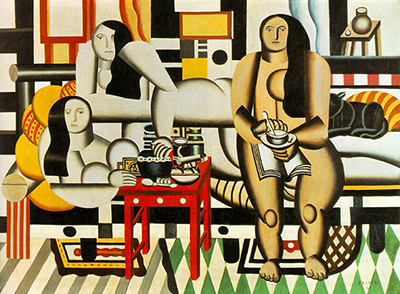Three Women is an oil on canvas painting by Fernand Léger, which the French artist did between 1921 to 1922. It's the most famous piece by Léger. The painting is among the artwork that signified the painter's return to the classical style on the 1920s after spending the 1910s on abstract art.
Léger held a firm believe in the modern industry and tried to incorporate that into his pieces. Three Women is an excellent example of how the French artist paved how own way on the classicism movement by including a machine aesthetic in his painting. Also called Le Grand Dejeuner, Three Women had its first exhibition at the 1921 Salon d'Automne. Leonce Rosenberg bought it but returned it after a short while because it was apparently 'too severe.' Léger reworked the piece in 1922, which was not something he would do in normal cases and so perhaps this patron was of particular importance to him, or that he was persuaded as to the merits of this course of action.
The Léger features three nude women set in a lavish modern apartment. They are all on a couch, enjoying a beverage, could be coffee or tea. Two of the women are lying on the couch while the other is sitting on the edge. A small coffee table is in front of them with a kettle, cups and a spoon set on it. Léger painted the reclining nudes in off-white with straight, shiny hair that falls freely in each woman's breast. The third form is a different colour - brown. She also has sleek black hair, a book on her lap and a teacup on one hand. Just behind her, a figure of what appears to be a dog curled on the sofa is visible. The apartment has vibrant and stylish decor. At the furthest end on the right of the painting is a vase resting on a stool. The background and floor consist of different colours that complement the plain nude subjects. Interestingly, there are also two different patterns which provides a contrast akin to a mathematical puzzle and provides further variation in terms of the angles used within the content.
An element that stands out in this painting is how Léger used different proportions to create the women. He exaggerated some of their body parts like the hips and backside while keeping others regular. The breasts are spherical as are the knees. The features look interchangeable between the three subjects. Léger was a combat engineer during WWI which is why the forms show great precision. The women have blank expressions that stare unflinchingly at the viewer. In letters that Léger wrote in 1942-1943, he insisted on the absence of emotion in the painting. It symbolises the lack of feeling in machines. Léger believed that machines had a significant role to play in modern future, and it was necessary for people to exist in harmony with them. Three Women depicts that by showing mechanised nude figures in a modern setting.
There is something mesmerising about this painting, in how three women stare directly at us, but within the strange Cubist world created by Leger. Some of his portraits are regarded as amongst his best paintings and the overall depiction of people within his work appeared more frequently from around 1910 onwards. They would also help to bring some identifiable to his paintings, at a time when abstract shapes were dominating in most cases. He remains one of the key elements of the Cubist movement, but with an approach that was unique in several ways and that laid him slightly on the fringes of this group because of the relative similarity between how Gris, Braque and Picasso would work in relative harmony.




